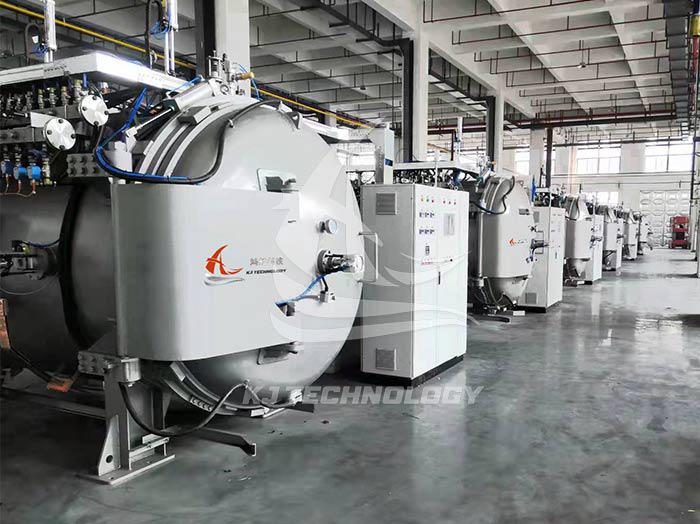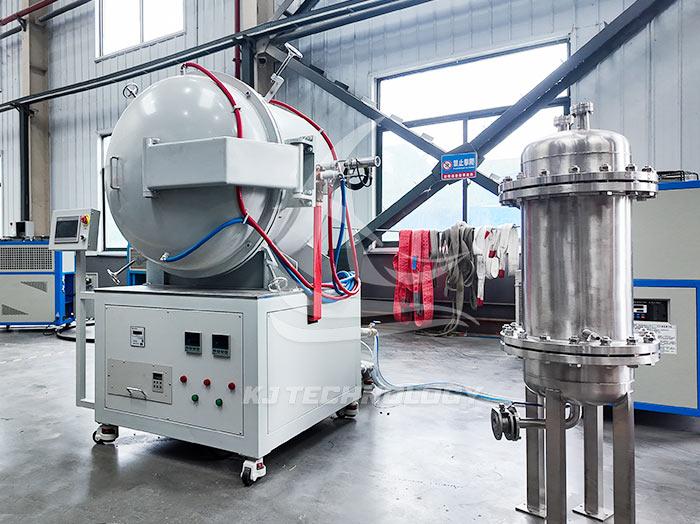High vacuum brazing of metals
 10-31-2025 Author: KJ technology
10-31-2025 Author: KJ technology
High vacuum brazing is a precision welding technique performed in a vacuum environment, suitable for connecting various metal materials. The following introduces the principles, advantages, materials, application fields, and process points:
principle
Heat the metal material together with a brazing material with a melting point lower than the base material in a vacuum environment to a temperature range higher than the melting point of the brazing material but lower than the melting point of the base material. At this time, the base material remains in a solid state, and the liquid brazing material is filled into the joint gap of the workpiece by capillary action. Through mutual diffusion with the base material, metallurgical bonding is formed, ultimately achieving high-strength connection of the workpiece.
advantage
Avoiding oxidation: The vacuum environment reduces the oxygen partial pressure in the brazing area, which can remove the oxide film on the surface of the welded part, protect the welded part from oxidation, and thus obtain high-strength, bright and dense joints, especially suitable for precision connections of easily oxidizable materials such as titanium alloys and high-temperature alloys.
Improving quality: The wetting and flowability of the brazing material are good, which can weld more complex and narrow channel devices, improve product yield, and obtain a sturdy and clean working surface.
Cost reduction: No need to use soldering flux, not only saving expensive metal soldering flux, but also eliminating complex flux cleaning processes, reducing production costs. Meanwhile, the internal structure and fixtures of the furnace have a long lifespan, which can reduce maintenance costs.
Strong adaptability: capable of connecting various heterogeneous materials such as aluminum, stainless steel, titanium alloy, ceramics, etc., with higher production efficiency.
Suitable for metal materials
Common metals: stainless steel, nickel based alloys, high-temperature alloys, heat-resistant steels, aluminum, aluminum alloys, copper, copper alloys, titanium, chromium, chromium alloys, etc.
Specific case:
Aerospace field: The honeycomb sealing ring of an American company's engine is made by vacuum brazing the ring and honeycomb sandwich; The fuel manifold of the engine consists of a main pipe, multiple branch pipes, and nozzles that are vacuum brazed together; The engine stainless steel heat exchanger is composed of over 300 stainless steel tubes, partitions, and shells that are vacuum brazed together; The stator rings of the 12th and 13th stage compressors of JT8D engine are made of inner and outer rings and dozens of blades by vacuum brazing. The engine casing of a certain engine in the United States is made of over 240 nickel alloy parts with a thickness of 0.25-0.7mm, which are vacuum brazed in three stages.
Automotive industry: A certain American automotive company uses vacuum brazing technology to produce aluminum radiator cores, which improves the heat exchange performance of the radiator and is lightweight. A Japanese aluminum industry company has developed a new series of alloys suitable for vacuum brazing automotive heat exchanger fins, improving corrosion resistance and service life.
Other fields: The vacuum brazed small and medium-sized drill bits developed by Northwest Institute of Mining and Metallurgy are widely used in construction industries such as metallurgy, geology, coal, water conservancy, railways, and military industry, with a service life that meets or exceeds the level of similar foreign products.
Application field
Aerospace: Manufacturing structural components and parts of aircraft and spacecraft, such as engine parts, turbine blades, heat exchangers, fuel nozzles, and other key components, to ensure the strength and airtightness of welded joints.
Automotive industry: Manufacturing components such as exhaust systems, turbochargers, heat exchangers, engine blocks, etc. to meet the high-precision and high-quality welding requirements of automotive engines, transmissions, and other components.
Electronic industry: Manufacturing high-precision electronic components such as circuit boards, connectors, and semiconductor devices, ensuring the stability and reliability of solder joints, improving the performance and lifespan of electronic products, and playing an important role in the field of electronic packaging.
Other fields: Suitable for products that require high airtightness and are relatively thin, as well as welding of various metals and non metals, such as copper water-cooled plates, thin aluminum water-cooled plates, tube heat exchangers, etc. It is also widely used in fields such as medical devices, diamond tools, PDC oil drill bits, and cutting tools made of various hard materials.
Key process points
Solder selection: The melting point of the solder should be lower than that of the base material, and the chemical composition of the solder should match that of the base material to ensure welding quality. For example, Sn/Pb alloys have good wetting and flowability, but due to the toxicity of Pb, they are gradually being replaced by lead-free solder; Ag Cu alloy has good wettability and high temperature strength, suitable for various joint forms; Au solder has good oxidation resistance and corrosion resistance, making it suitable for products that require high durability, but it is expensive; Cu Cr alloy has good thermal stability and high-temperature strength, suitable for high-temperature brazing, but the cost is relatively high.
Process parameters: brazing temperature, insulation time, cooling rate, and other process parameters need to be adjusted according to specific situations to ensure welding quality. Usually, it is necessary to conduct experiments to determine the optimal process parameters. For example, in a study conducted by a university in Harbin on the vacuum brazing of surface activated Al ₂ O Ⅲ ceramics and 5005 aluminum alloy, the heating rate was 15 ℃/min, the brazing temperature was raised to 600-620 ℃, and then held for 5 minutes. The temperature was then reduced to 300 ℃ at a rate of 10 ℃/min and cooled in the furnace. The vacuum degree inside the furnace was higher than 1.0 × 10 ⁻ ³ Pa, and the highest shear force of the brazed joint obtained under this process was up to 15MPa.








